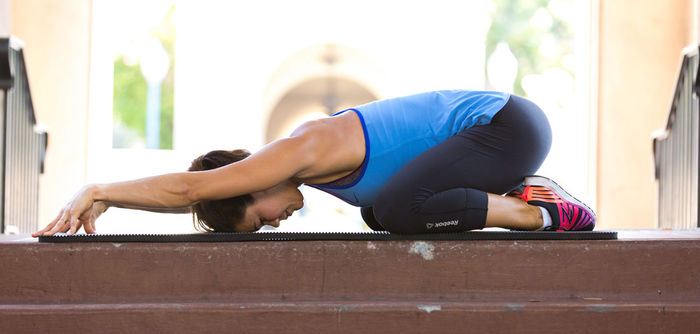To help your clients get the most out of their time in the gym, practice these three programming tips:
- Use foundation lifts.
- Use complex training.
- Use recovery as a training tool.
Foundation Lifts
Foundation lifts are resistance exercises that work the major muscle groups. Because they target the largest muscle groups and increase metabolism, they work best for general fitness and weight loss goals. Foundation lifts are broken down into the four categories:
- Bilateral lower-body exercises
- Unilateral lower-body exercises
- Upper-body exercises
- Core exercises
Note that the exercises presented below are not a comprehensive list. They are suggested exercises and a good starting place to ensure all major muscles are included.
Bilateral Lower-body Exercises
- Squats
- Front
- Back
- Modified deadlift
- Seated leg press
Unilateral Lower-body Exercises
- Forward or walking lunge
- Side lunge
- Back lunge
- Bulgarian split squat
- Single-leg squat
- Step up
Upper-body Exercises
- Barbell or dumbbell bench press
- Cable, machine, or band row
- Barbell or dumbbell bent-over row
- Dips
Core Exercises
- Plank
- Modified knee plank
- Bicycle crunch
- Reverse crunch/leg raise
- Swiss ball crunch
Sample Foundation Lift Workout
|
Exercise |
Sets |
Repetitions |
Resistance |
Rest Between Sets |
|
Barbell Bench Press |
2–4 |
8–15 |
65–85% 1 RM |
0–60 seconds |
|
Barbell Bent-over Row |
2–4 |
8–15 |
65–85% 1 RM |
0–60 seconds |
This workout is an agonist-antagonist superset. To modify and/or progress the routine, increase or decrease the number of sets or repetitions, resistance or intra-set recovery periods. Other programming suggestions include super-setting upper and lower-body exercises, including core exercises in supersets, and utilizing circuits of three or more exercises.
Complex Training
Combined resistance and plyometric training is called complex training, and is designed to improve muscle strength (how much force a muscle can produce) and power (how quickly muscle force is produced). Because one of the primary goals of complex training is power development, it is favored in athletics training. With strategic modifications, however, it can be an extremely effective training tool for general fitness and weight loss for intermediate to advanced clients.
Referring back to the foundation lifts, pair a foundation exercise with a plyometric exercise from the list below to design a complex workout.
Suggested Plyometric Exercises
- Squat jumps
- Box jumps
- Tuck jumps
- Bulgarian jump split squat
- Cycled split jumps
- Single-leg push off
- Depth and/or plyometric push-ups
- Smith machine explosive press
Once the exercises are selected, the best practice is to superset two to four sets of the foundation lift with two to four sets of the plyometric lift as shown in the sample workout below.
Sample Complex Training Workout
|
Exercise |
Sets |
Reps |
Resistance |
Rest Between Sets |
|
Front squat (foundation) |
2–4 |
8–15 |
65–85% 1 RM |
20–60 seconds |
|
Tuck jumps (plyometric) |
2–4 |
6–10 |
Body-weight only |
20–60 seconds |
Trainer’s Tips:
- Because the intensity is higher for the plyometric drill than the foundation lift, the suggested number of repetitions is lower.
- The recovery period should be longer after the plyometric set versus the foundation lift.
- Where appropriate, you can add external weight to the plyometric drills but it is advised to complete at least one set without resistance to check the mechanics prior to adding weight.
To modify the level of difficulty within a complex training set, increase or decrease external weight to change intensity. Volume can be increased or decreased by changing the number of repetitions. And finally, incorporate shorter or longer intra-set recovery periods to modify the intensity of the entire workout.
Recovery as a Training Tool
The key to using recovery as a training tool is to recognize that recovery is an active physiological process that plays a key role in conditioning, building muscle and performance. The length and composition of intra-set recovery periods are critical programming variables. During a session, active recovery could be something like jogging in place or dynamic stretching between sets. Moving around between sets readies the muscles and other supporting systems such as the heart for what is next. It also keeps metabolic rate up, improving cardiovascular fitness and increasing the utility of exercise for weight loss.
After training, recovery is even more vital. It is during recovery that the actual rebuilding of muscle tissue occurs and muscles gain mass and strength. During training, muscle is broken down or catabolized; conversely, muscles rebuild or anabolize during post-session recovery.
When it comes to using recovery as a positive programming tool, intra-set recovery periods are critical. However, the length of time between sessions is equally as important. Research suggests that 48 hours of rest is required for muscles to return to baseline strength after high-intensity training (85% 1RM or higher). Keep in mind, however, that inactivity for more than 96 hours may lead to detraining (Carter and Greenwood, 2014).
By following a few key programming strategies, it is easy to safely and effectively build, modify and progress your client’s workouts and programs.
Want to learn more from Amy Ashmore? Check out our Programming for Strength Gains: New Research Exposes Timing as the Key Variable online course.
Reference
Carter, J. and Greenwood, M. (2014). Complex training reexamined: Review and recommendations to improve strength and power. Strength and Conditioning Journal, 36, 2, 11–19.




 by
by 








 by
by